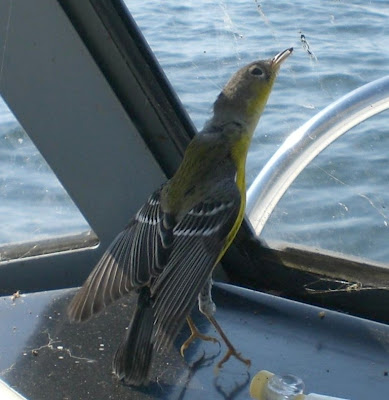 The time is ripe for the harvest of jewelweed fruit. Jewelweeds, sometimes called Touch-me-nots, are tall succulents that form colonies and have interesting yellow or orange flowers, depending on the species. The one above is Pale Jewelweed, Impatiens pallida. And this specimen has perfectly ripe fruit ready for the picking.
The time is ripe for the harvest of jewelweed fruit. Jewelweeds, sometimes called Touch-me-nots, are tall succulents that form colonies and have interesting yellow or orange flowers, depending on the species. The one above is Pale Jewelweed, Impatiens pallida. And this specimen has perfectly ripe fruit ready for the picking..JPG) Here's the booty, if you are a careful harvester. Each fruit contains a few brownish rugulose seeds, but one must use special procedures to pluck them. The walls of the fruit are under tension, and when one jostles a fully ripened specimen, POP! Out they explode, as the fruit essentially explodes under pressure, hurling its tiny charges up to several feet away with astonishing speed.
Here's the booty, if you are a careful harvester. Each fruit contains a few brownish rugulose seeds, but one must use special procedures to pluck them. The walls of the fruit are under tension, and when one jostles a fully ripened specimen, POP! Out they explode, as the fruit essentially explodes under pressure, hurling its tiny charges up to several feet away with astonishing speed.So, just grab the entire container in your hand as if you're seizing a jumping bug that you don't wish to escape. The explosion will then occur within your closed fist and you'll have the tasty seeds. That's right. Tasty. As in freshly shelled walnuts, because that's what they taste like, to me at least. You'll work for a meal, though - it probably takes 943 of these wee seeds to fill up an average humanoid.
.JPG) One of our more conspicuous and beautiful plants at this season is Virginia Creeper, Parthenocissus quinquefolia. I suspect the fruit are much less noticed than is the foliage, but as you can see creeper inflorescences are a thing of remarkable good looks, the blue berries contrasting almost jarringly with the red pedicels.
One of our more conspicuous and beautiful plants at this season is Virginia Creeper, Parthenocissus quinquefolia. I suspect the fruit are much less noticed than is the foliage, but as you can see creeper inflorescences are a thing of remarkable good looks, the blue berries contrasting almost jarringly with the red pedicels..JPG) Virginia Creeper is a high-climbing vine, easily capable of ascending to the tops of tall trees. Here it clambers up an Eastern Cottonwood, Populus deltoides. This common plant turns a gorgeous scarlet-red in autumn, and heavily festooned trees glow with its foliage and can be seen from afar. Sometimes people will confuse it for Poison Ivy, Toxicodendron radicans, but that plant does not turn such a rich red, and of course it has leaves of three leaflets; not the five of this species.
Virginia Creeper is a high-climbing vine, easily capable of ascending to the tops of tall trees. Here it clambers up an Eastern Cottonwood, Populus deltoides. This common plant turns a gorgeous scarlet-red in autumn, and heavily festooned trees glow with its foliage and can be seen from afar. Sometimes people will confuse it for Poison Ivy, Toxicodendron radicans, but that plant does not turn such a rich red, and of course it has leaves of three leaflets; not the five of this species..JPG) A tree well cloaked in creeper. Strongly adhesive discs at the end of prolific tendrils allow Virginia Creeper to scale to great heights. We do have another, much less known species, called Woodbine, Parthenocissus vitacea. It lacks the adhesive discs and thus can't seem to climb nearly as well. Thus, it typically forms a scrambling ground cover. For a wonderful treatment of these two species, see my friends in Indiana. Finally, the urban Boston Ivy, Parthenocissus tricuspidata, is a frequent sight climbing the brick halls of academia and other buildings, but it, fortunately, does not jump the fence and escape to the wild.
A tree well cloaked in creeper. Strongly adhesive discs at the end of prolific tendrils allow Virginia Creeper to scale to great heights. We do have another, much less known species, called Woodbine, Parthenocissus vitacea. It lacks the adhesive discs and thus can't seem to climb nearly as well. Thus, it typically forms a scrambling ground cover. For a wonderful treatment of these two species, see my friends in Indiana. Finally, the urban Boston Ivy, Parthenocissus tricuspidata, is a frequent sight climbing the brick halls of academia and other buildings, but it, fortunately, does not jump the fence and escape to the wild.Enjoy the colors of creeper and other fall foliage will you can; it'll be gone before we know it.

.JPG)
.JPG)
.JPG)
.JPG)
.JPG)
.JPG)
.JPG)
.JPG)
.JPG)
.JPG)

_001.jpg)
.JPG)
.JPG)

.JPG)
.JPG)
.JPG)
.jpg)
.jpg)
.jpg)
.JPG)
.JPG)
.JPG)
.JPG)
.JPG)
.JPG)
.JPG)
.JPG)
.JPG)
.JPG)
.JPG)
.JPG)

.JPG)
.JPG)
.JPG)




.JPG)
.JPG)
